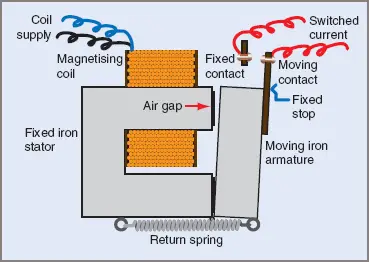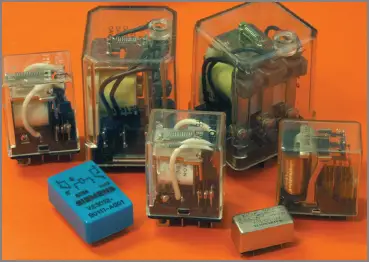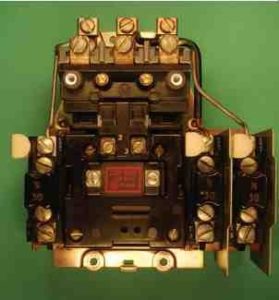In this article, you’ll learn about electromagnetic relay construction, its working/operating principle, and different types, such as No-Volt relay, Overload relay, and Polarized relay, which have different structures and operating principles.
What is an Electromagnetic Relay?
An electromagnetic relay is a switch operated by a magnetic coil. The relay switch consists of a solenoid that has a fixed iron core and a part that is movable. A spring is often used to provide the force to hold the movable portion (the armature) away from the fixed portion (the stator or core) when the solenoid is de-energized.
When the coil is energized, the armature is pulled against the stator, closing the magnetic circuit and mechanically closing (or opening) one or more sets of contacts.
Relay switches operate electrical contacts for closing or opening a circuit, while solenoids operate a plunger to effect a mechanical operation.
Electromagnetic Relay Working Principle
Figure 1 shows a simple attracted-armature type of electromagnetic relay (relay switch) used to open or close an electrical circuit.

Figure 1 Electromagnetic Relay Labeled Diagram
When current flows in the operating coil, a magnetic flux is created in the soft iron core and around the magnetic circuit, including the armature and the air gap. If the air gap between the core and the armature is not too large, most of the core flux will pass through the armature and induce polarities in the pole faces of the armature and core, creating a magnetic force that will attract the armature to the pole face.
The force of attraction between the armature and the core is greater than the force holding the armature in the open position (due to the spring). The armature will close and hold for as long as the magnetic flux is applied and is strong enough.
The force exerted on the armature in the closed position (minimum air gap) will be many times greater than when the armature is in the fully open position (maximum air gap).
For a coil connected to a direct current supply, the current will be constant for all positions of the armature, but the reluctance of the magnetic circuit will change with the length of the air gap, as the reluctance of air is much greater than the reluctance of the iron core.
For an alternating supply, conditions are somewhat different due to the coil current being dependent on the flux and the reluctance of the magnetic circuit. If the ampere-turns are great enough to create the tractive force necessary to close the armature through a large air gap, then this same force will often leave a residual flux in the magnetic circuit. This residual magnetism may be strong enough to keep the armature closed even when the coil current is switched off.
This problem can be overcome by using a non-magnetic spacing piece on one pole face to ensure that a certain minimum air gap is left in the magnetic circuit when the armature is in the fully closed position. The length of this gap must be such that the residual magnetism is not sufficient to maintain the armature in the closed position.
Electromagnetic Relay Types
There are different types of electromagnetic relays, such as No-Volt relays, Overload relays, and Polarized relays, which have different structures and operating principles.
No-Volt Relays
Some electrical machines are prone to failure when the supply voltage is lower than the value the machine was designed for. No-volt relays, low-volt relays, or brown-out relays, as they are also called, are circuit-closing relays with an operating coil connected across the supply voltage. The armature and contacts close when the supply is energized at the expected level and are held closed as long as the voltage across the coil is above a designed value, which is some percentage of the normal circuit voltage.

Figure 2 No-Volt Electromagnetic Relays
A brown-out is where a supply fault causes the supply voltage to be reduced, but it is not zero as it is in a black-out.
When the circuit voltage falls below the minimum allowable value, the armature is released, and the relay contacts open. Therefore the control circuit of the apparatus being protected stops the machine to prevent damage.
Overload Relays
Another common electromagnetic protective relay is the overload relay. The operating coil of this relay is connected in series, so the flux comes from the current flowing in the circuit. When the circuit current exceeds a designed value, the armature is attracted, and the relay pulls a trigger to disconnect the contacts, thus disconnecting the overloaded circuit from the supply. Once triggered, an operator may need to reset the relay before the machine can be re-started.

Figure 3 Three single-phase overloads electromagnetic relay Diagram
In this type of relay, the important feature is the length of the air gap between the core and armature poles because this controls the value of the ampere-turns necessary to attract the armature and, therefore, operate the relay.
Polarized Relays
Polarized relays operate only when the polarity of a DC supply is correct. A polarized relay might be used to prevent a battery charger from attempting to charge a battery in the wrong polarity, which would not be good for the battery. Polarized relays can also be used to protect electronic equipment from reverse polarity, which can destroy electronic components. Typically, Polarized relays have an electronic diode in series with the coil, thus only allowing the coil to operate when the polarity of the voltage on the coil is correct.
Figure 4 Polarized Electromagnetic Relay Diagram
Frequently Asked Questions (FAQs) about Electromagnetic Relays
What is an electromagnetic relay?
An electromagnetic relay is an electrical switch that operates using an electromagnet to control the opening or closing of one or more electrical contacts. It acts as an interface between low-power control circuits and high-power circuits.
How does an electromagnetic relay work?
An electromagnetic relay consists of a coil and one or more sets of contacts. When a current flows through the coil, it generates a magnetic field that attracts or releases a movable armature, which in turn opens or closes the contacts, allowing or interrupting the flow of current.
What are the types of electromagnetic relays?
There are various types of electromagnetic relays, including:
– SPST Relay: Single Pole Single Throw relay with one set of contacts.
– SPDT Relay: Single Pole Double Throw relay with one set of normally open and one set of normally closed contacts.
– DPDT Relay: Double Pole Double Throw relay with two sets of contacts.
– Latching Relay: It maintains its state after the power is removed.
– Solid State Relay: Utilizes semiconductors instead of mechanical parts for switching.
What are the applications of electromagnetic relays?
Electromagnetic relays are used in various applications, including:
– Power Distribution: In circuit breakers, protection systems, and control panels.
– Automotive Industry: For controlling lights, motors, and other components.
– Industrial Automation: In PLCs, robotics, and motor control.
– Telecommunications: In switching and routing systems.
– Home Automation: For lighting, heating, and air conditioning control.
What are the advantages of electromagnetic relays?
– High Voltage and Current Handling: They can switch high power loads.
– Isolation: Provide electrical isolation between control and load circuits.
– Reliability: Generally, they have a longer lifespan and are less prone to failure.
What are the disadvantages of electromagnetic relays?
– Mechanical Wear: Mechanical contacts can wear out over time.
– Slow Switching Speed: Compared to solid-state devices, they have slower switching times.
– Coil Power Consumption: The coil requires continuous power to maintain the relay state.
How do I choose the right electromagnetic relay for my application?
Consider factors like the required voltage and current ratings, the number of contacts needed, the switching speed, whether latching or non-latching is required, and the environment (temperature, vibration, etc.).
How do I test and troubleshoot electromagnetic relays?
You can use a multimeter to test coil resistance and contact continuity. If the relay fails to operate, check the power supply, coil resistance, and ensure there’s no mechanical obstruction affecting the armature movement.
Can electromagnetic relays be used with microcontrollers or digital circuits?
Yes, relays can be used with microcontrollers and digital circuits. However, an interface circuit (like a transistor or optocoupler) is often required to provide the necessary current to energize the relay coil.
Can I replace electromagnetic relays with solid-state relays?
Yes, solid-state relays can be a suitable alternative in many cases. They offer faster switching times, longer lifespan, and reduced noise generation due to their lack of moving parts. However, they might not handle high-voltage or high-current applications as effectively as electromagnetic relays.
Remember that electromagnetic relays have been widely used for decades and continue to be a crucial component in various industries due to their versatility and reliability.
